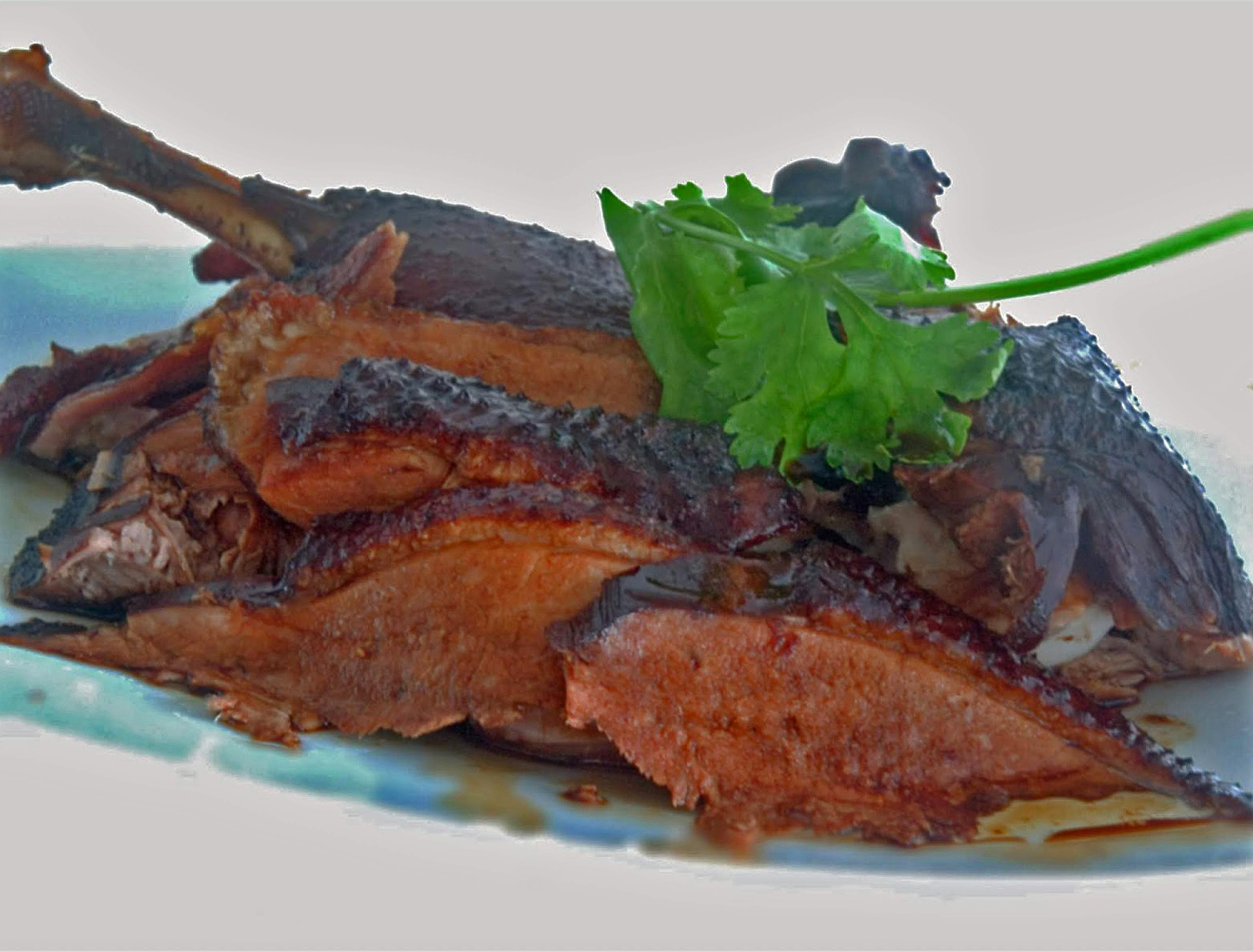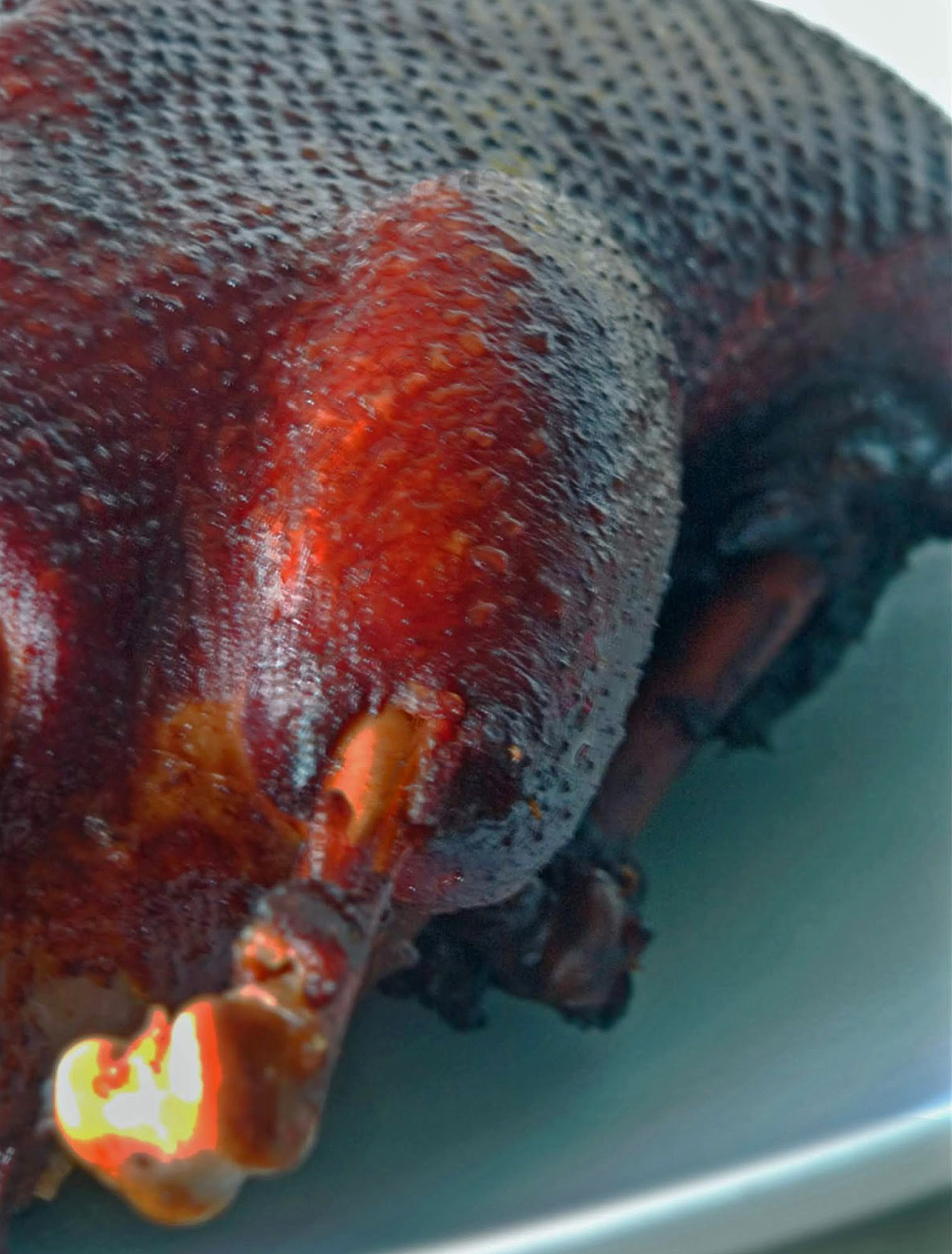Teochew Braised Duck

Teochew braised duck (潮州滷鸭) was my mother’s pièce de résistance. She always had a dark, glistening duck for the dinner table on Chinese New Year eve. It was a fantastic complement to our steamboat dinner, something that we could eat whilst the raw stuff was cooking. To us, Chinese New Year, Mum and 滷鸭 were all one and the same thing.
One day, Mum wasn’t around anymore. She left us just before Christmas, and as Chinese New Year loomed, I thought we were going to have the reunion dinner without 滷鸭. But I was wrong.
My brother, the new head of the family, gallantly undertook the onerous task of braising a duck with caramel and dark soya sauce. His first attempt left much to be desired, to put it mildly. We all picked at the 滷鸭 half-heartedly. No one said anything about the tasteless duck. In fact, no one said anything at all.
Everyone kept their heads down and ate in silence. Usually, we would be chattering about, 
Time passes, and our reunion dinner is now jolly and lively again. We attack my brother’s duck with great gusto because it has improved by leaps and bounds. His Braised Duck now has the wonderful fragrance of caramel that was the trademark of Mum’s 滷鸭. It took him several attempts to get the balance of ingredients and flavours just right.
I think I should – ahem! – take some credit in reengineering the recipe. I remember Mum saying “two and three”. It was either two tablespoonful of salt and three tablespoonful of sugar. Or it might be three tablespoonful of salt and two tablespoonful of sugar. Always heaped, never leveled. Very helpful, right?
The special ingredient in my mother’s recipe is caramel. The duck is basted with a mix of caramel and dark soya sauce for 15 minutes before it’s braised. This gives her duck the trademark dark, glistening sheen which is rarely seen on those that are not home cooked. To let the wonderful caramel flavour take centre stage, my mother’s recipe doesn’t use any spices like star aniseeds or cinnamon. There’s PLENTY of galangal though, which is indispensable for teochew braised duck.
One of the purposes for having this blog is to record my mother’s recipes. With Chinese New Year just round the corner, there’s no better time than now to share her Spring Festival pièce de résistance: Teochew braised duck. Hope you like it as much as we do. Happy Year of the Tigress! Roar!
(For 10 persons)
1 duck
4 tsp salt for marinating duck
200 g galangal, washed and sliced ¼ cm thick
15 cloves garlic with peel, washed
8 tbsp sugar
12o ml dark soya sauce (I use Tiger brand, special grade)
1 tbsp salt for seasoning stew
1 sprig coriander, washed and cut 2-3 cm long
Optional
5 pieces beancurd
10 hard-boiled eggs, peeled
1. Remove duck head, neck, bottom, feet and first 2 joints of wings. Or you can leave them on if your wok or Dutch oven is big enough. I usually keep these bits and pieces for soup. Remove any remaining small feathers on the duck with a pair of tweezers. Bring a kettle of water to a boil. Place duck in a wok. Slowly pour boiling water all over duck. When cool enough handle, wash duck thoroughly under running water. Dry with paper towels. Rub salt evenly over duck, inside and outside. Leave duck overnight in the refrigerator, covered.
2. Remove duck from refrigerator. Tuck half of galangal and garlic in duck’s cavity. Place sugar in a wok on high heat. (Have a small bowl of water ready if you’ve never made caramel before). When sugar turns liquid, swirl it round the wok now and then. When caramel turns medium brown, reduce heat to very low. Continue swirling till colour turns dark brown (like tea or dark honey) and sugar is no longer sweet but not yet bitter. If you’re not sure, dip a spoon in the caramel, then cool it in the bowl of water. Taste the caramel. If it’s sweet, give it a few more seconds. If it’s bitter, throw it away and start again!
3. When caramel is ready, add ½ cup water. Be careful of the burst of steam. Heat till caramel melts again. Add dark soya sauce and stir to mix well. Bring mixture to a boil. Lower duck into the wok. Keep sauce bubbling slowly over low heat. Baste for 15 minutes or so till duck turns dark with the colour of caramel and dark soya sauce. Add enough water to cover half the duck (about 400 ml). Add salt, and remaining galangal and garlic. Bring mixture to a boil. Reduce heat to low and simmer gently, covered.
4. Baste once every 15-20 minutes. Turn duck over (carefully!) after 40 minutes. Duck’s ready after 1¼ hours (depending on the breed and age), or 1½ hours if you like it really soft and tender. Turn off heat. Remove duck to a plate to cool down. Carve or chop into bite-size pieces, and drizzle with some stewing sauce (without oil). Garnish with coriander. Serve with a mix of the stewing sauce (without oil), light soya sauce and a bit of white sesame sauce as a dip. Or a mix of white vinegar, chopped chilli padis, garlic, salt and sugar. Or sambal chilli.
5. If adding hard-boiled eggs and beancurd, simmer these very, very gently for an 1 hour or so in the braising sauce after the duck’s removed. Do not boil furiously or beancurd would loose its creamy texture. Alternatively, marinate eggs and beancurd overnight in the sauce. Bring to a boil the next day. Serve.